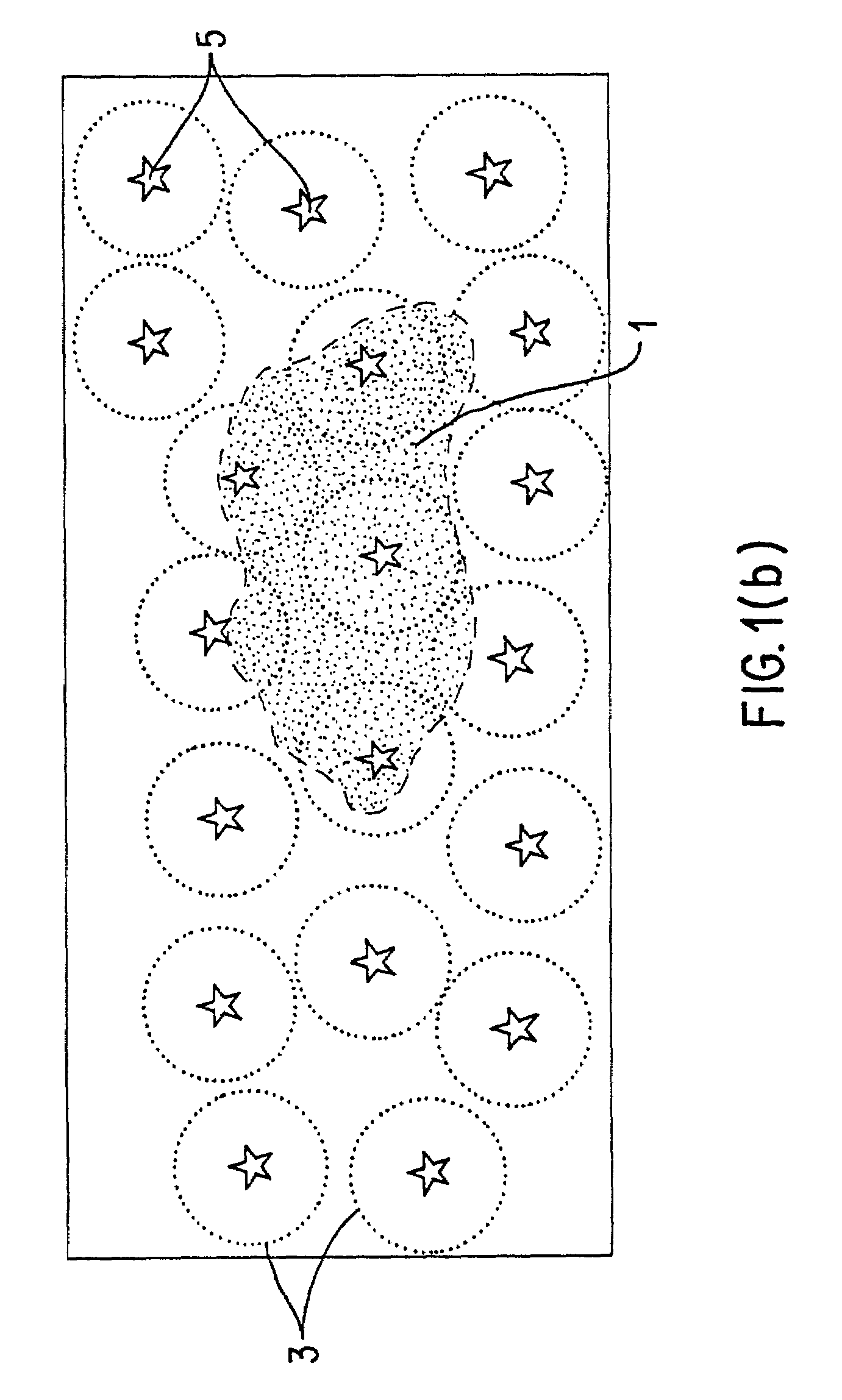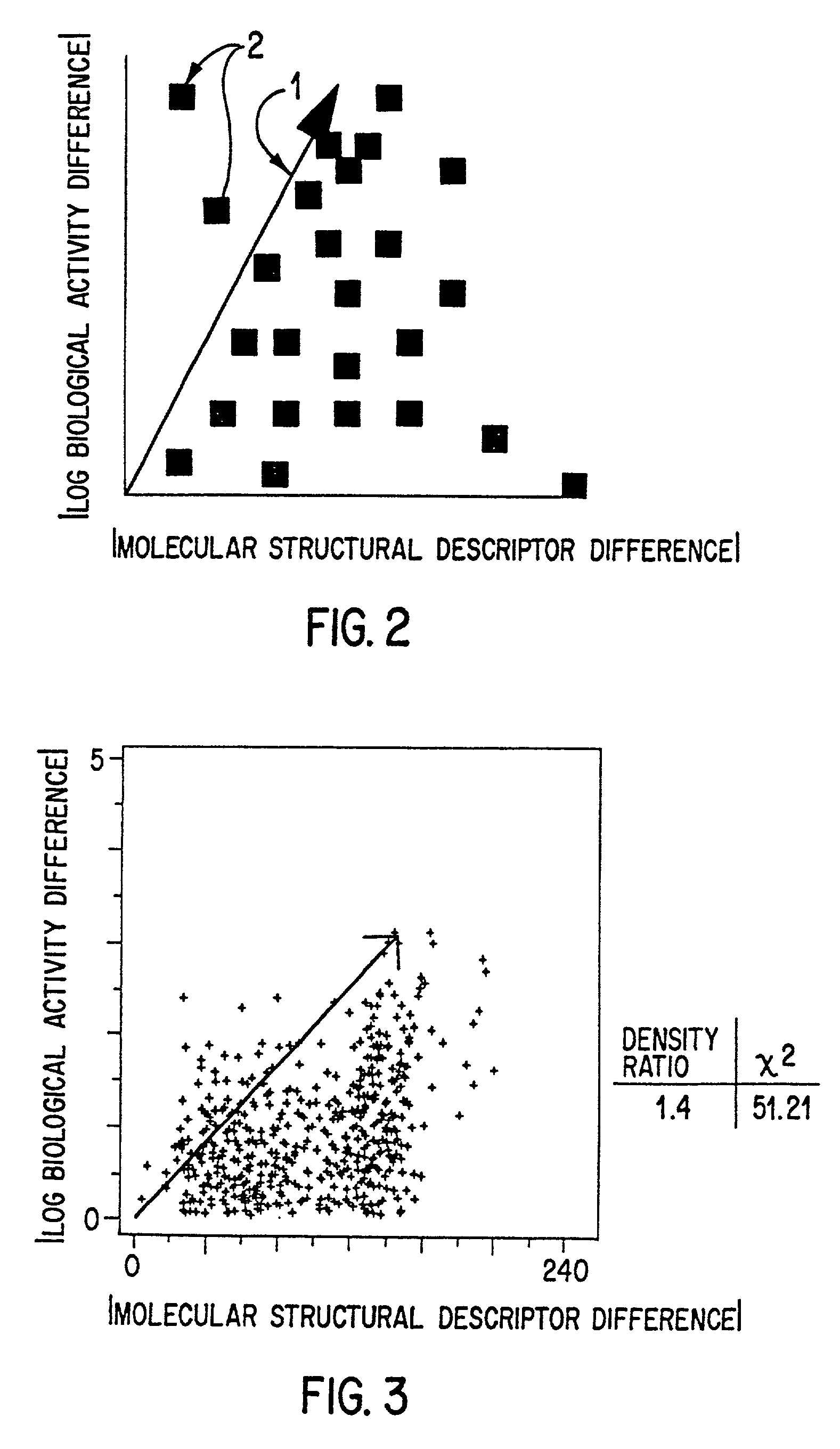As the art has recognized, however, no method currently exists to distinguish those descriptors that quantify useful aspects of similarity from those which do not.
The difficulty is to find a useful
design space—a quantifiable dimensional space (metric space) in which compounds with similar biological properties cluster; ie., are found measurably near to each other.
However, with no knowledge of the validity / usefulness of the descriptor employed, and no guidance with respect to the size or spacing of clusters to be expected from any given descriptor, prior art clustering has been, at best, another intuitive “seat of the pants” approach to diversity measurement.
The docking procedure, which must be applied to every design candidate for each polyomino, requires a considerable amount of
CPU time (is computationally expensive).
However, a problem with this approach is the conceptually severe (unjustified) approximation of representing all possible irregularly shaped
receptor cavities by only about a dozen assemblies of smooth-sided polyomino cubes.
However, QSARs essentially map only the space of a particular
receptor, do not provide information about the validity of other descriptors, and would be generally inapplicable to construction of a combinatorial screening library designed for screening unknown receptors or those for which no QSAR data was available.
No indication was given of whether their descriptor was valid in the sense defined above, and, clearly, such a procedure would be too
time consuming to apply to a truly large combinatorial
library design.
However, as we have seen, if the metric used in the
cluster analysis is not initially valid (does not define a subspace in which molecules with similar
biological activity cluster), then no amount of manipulation will prevent the sample from being essentially random.
Worse yet, an invalid metric might not yield a selection as good as random!
Another related problem in the prior art is the failure to have any objective manner of ascertaining when the library subset under design has an adequate number of members; that is, when to stop sampling.
Any stopping point may or may not sample sufficiently or may oversample.
In fact, the prior art has not recognized a coherent
quantitative methodology for determining the end point of selection.
Short of such total sampling, users of prior art library subsets constructed along the lines noted above do not know whether a random sample, a representative sample, or a highly skewed sample has been screened.
Several other problems flow from the inability to rationally select a combinatorial screening library for optimal diversity and these are related both to the
chemistry used to create the combinatorial library and the screening systems used.
First, because many more molecules may have to be synthesized than may be needed,
mass synthetic schemes have to be devised which create many combinations simultaneously.
In fact, there is a good deal of disagreement in the prior art as to whether compounds should be synthesized individually or collectively or in solution or on
solid supports.
Within any synthetic scheme, an additional problem is keeping track of and identifying the combinations created.
While the synthesis of any individual combinatorial molecule may be straightforward, much time and effort has been and is still being expended to develop synthetic schemes in which hundreds, thousands, or tens of thousands of combinatorial combinations can be synthesized simultaneously.
Many approaches in the prior art therefore face “
deconvolution” problems; ie. trying to figure out what was in an active mixture either by following the synthetic reaction pathway, by resynthesizing the individual molecules which should have resulted from the reaction pathway, or by
direct analysis of duplicate samples.
Another major problem with the inclusion of multiple and potentially non-diverse compounds in the same screening mixture is that many assays will yield false positives (have an activity detected above a certain established threshold) due to the combined effect of all the molecules in the screening mixture.
Further problems in the prior art arise in the attempt to follow up leads resulting from the screening process.
While, within those constraints, all possible combinatorial molecules are synthesized for screening, finding a few molecules with the desired activity among such a library yields no information about what active molecules might exist in the universe accessible with the same
combinatorial chemistry but outside the limited (
receptor) library definition.
This is an especially troubling problem since, from serendipitous experience, it is well known that sometimes totally unexpected molecules with little or no obvious similarity to known active molecules exhibit significant activity in some biological systems.
Thus, even finding a candidate lead in a library whose design was based on knowledge of the receptor is no guarantee that the lead can be followed to an optimal compound.
For prior art library subsets designed around the use of some descriptor to cluster compounds, similar problems may exist.
Since the prior art does not possess a generally applicable method of validating descriptors, all screening performed with prior art libraries is suspect and may not have yielded all the useful information desired about the larger chemical universe from which the library subsets were selected.
Finally, as the expense in time and effort of creating and screening combinatorial libraries increases, the question of the uniqueness of the libraries becomes ever more critical.
To date, the prior art has been unable to answer these questions.
However, such an assumption contradicts the well known reality that biological receptors can recognize molecular similarities arising from different structures.
When screening for compounds possessing activity for undefined biological receptors, there is no way of telling a priori which
chemistry or chemistries is most likely to produce molecules with activity for that receptor.
Thus, screening with as many chemistries as possible is desired but is only really practical if redundant sampling of the same diversity space in each
chemistry can be avoided.
The prior art has not provided any guidance towards the resolution of these problems.
 Login to View More
Login to View More 


